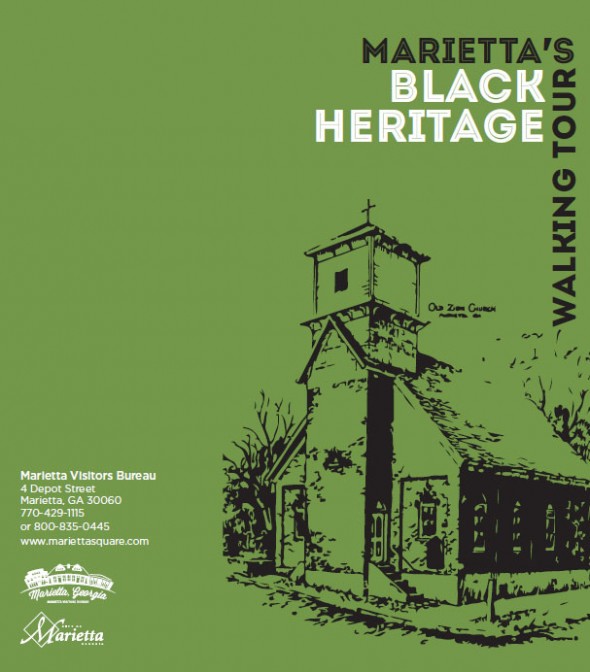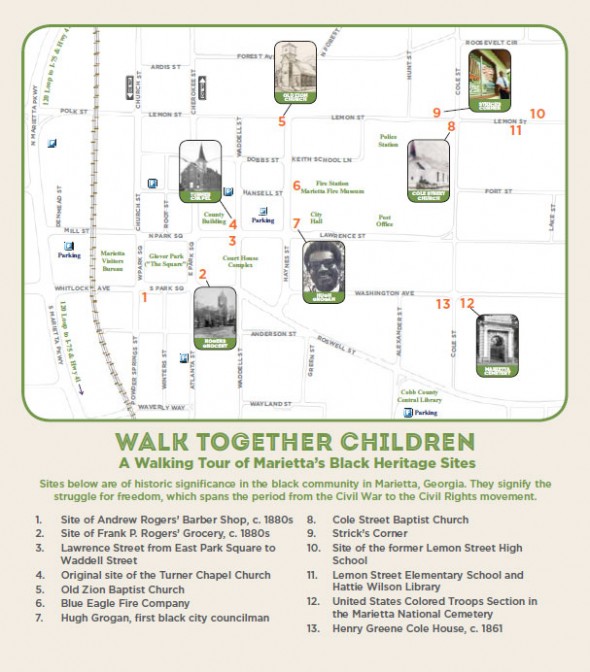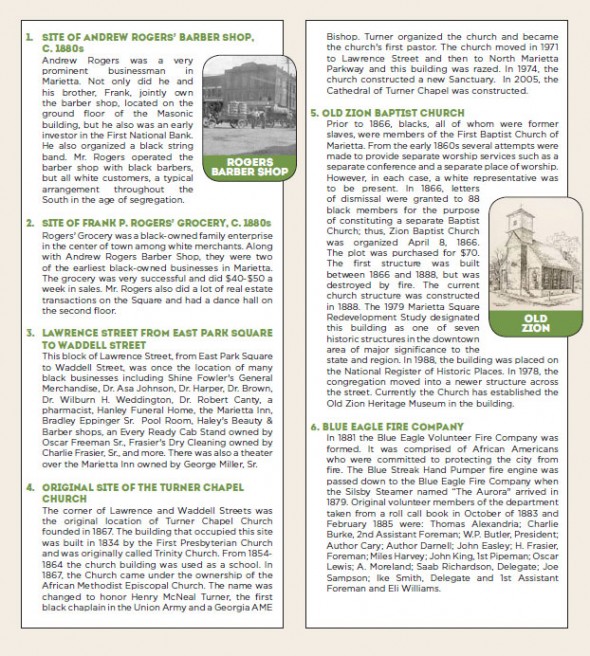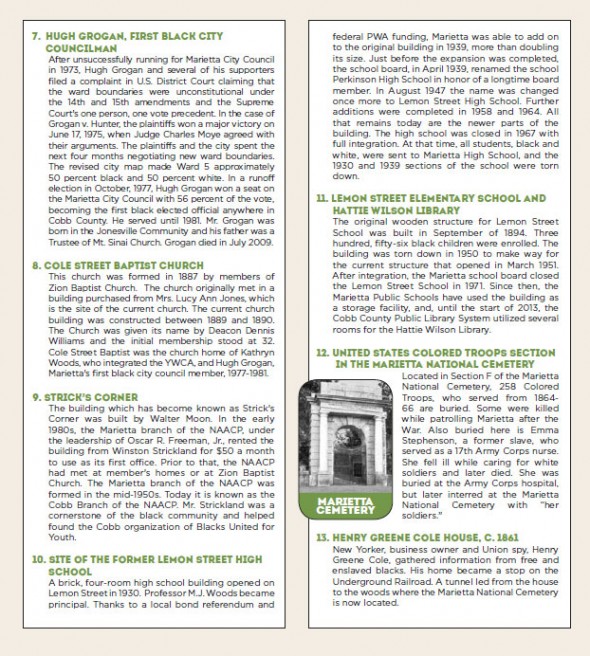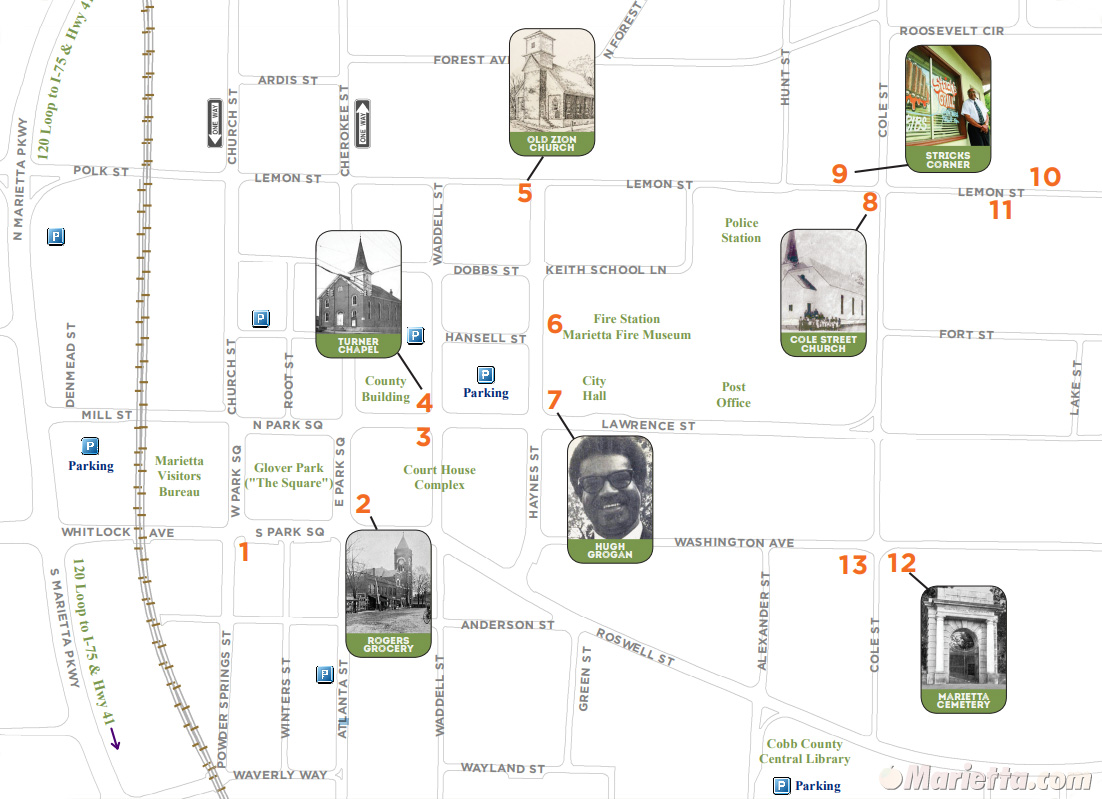 A Walking Tour of Marietta’s Black History Sites
A Walking Tour of Marietta’s Black History Sites
The Black Heritage Walking Tour highlights several historic sites that have played a part in Marietta’s African-American history and heritage. “We have a lot of black heritage sites around the downtown that were not marked and hadn’t been highlighted in any format in any type of brochure,” said then city manager Bill Bruton at the brochure unveiling on June 12, 2013. “As we go into the 150th anniversary of the Civil War and all the history that happened in Marietta, this is one of the first projects that we wanted to accomplish for our community.”
Sites below are of historic significance in the black community in Marietta, Georgia. They signify the struggle for freedom, which spans the period from the Civil War through the Civil Rights movement. Some of these historic structures still remain, while other structures have been altered or replaced.
Locations include:
- Site of Andrew Rogers’ Barber Shop, circa 1880s
- Site of Frank P. Rogers’ Grocery, circa 1880s
- Lawrence Street from East Park Square to Waddell Street
- Original site of the Turner Chapel Church
- Old Zion Baptist Church
- Blue Eagle Fire Company
- Hugh Grogan, First African-American city councilman, City Hall
- Cole Street Baptist Church
- Strick’s Corner
- Site of former Lemon Street High School
- Lemon Street Elementary School and Hattie Wilson Library
- United States Colored Troops Section in Marietta National Cemetery
- Henry Greene Cole House, circa 1861
1. Site of Andrew Rogers’ Barber Shop
1880s Andrew Rogers was a very prominent businessman in Marietta. Not only did he and his brother, Frank, jointly own the barber shop, located on the ground floor of the Masonic building, but he also was an early investor in the First National Bank. He also organized a black string band. Mr. Rogers operated the barber shop with black barbers, but all white customers, a typical arrangement throughout the South in the age of segregation.
30 S Park Square NE, Marietta, GA 30060
2. Site of Frank P. Rogers’ Grocery
1880s Rogers’ Grocery was a black-owned family enterprise in the center of town among white merchants. Along with Andrew Rogers Barber Shop, they were two of the earliest black-owned businesses in Marietta. The grocery was very successful and did $40-$50 a week in sales. Mr. Rogers also did a lot of real estate transactions on the Square and had a dance hall on the second floor.
https://goo.gl/maps/Aa1UJcXzafaqLMAy5
3. Lawrence Street from East Park Square to Waddell Street
This block of Lawrence Street, from East Park Square to Waddell Street, was once the location of many black businesses including Shine Fowler’s General Merchandise, Dr. Asa Johnson, Dr. Harper, Dr. Brown, Dr. Wilburn H. Weddington, Dr. Robert Canty, a pharmacist, Hanley Funeral Home, the Marietta Inn, Bradley Eppinger Sr. Pool Room, Haley’s Beauty & Barber shops, an Every Ready Cab Stand owned by Oscar Freeman Sr., Frasier’s Dry Cleaning owned by Charlie Frasier, Sr., and more. There was also a theater over the Marietta Inn owned by George Miller, Sr.
https://goo.gl/maps/NHuuGndAueWcnixi9
4. Original Site of The Turner Chapel Church
The corner of Lawrence and Waddell Streets was the original location of Turner Chapel Church founded in 1867. The building that occupied this site was built in 1834 by the First Presbyterian Church and was originally called Trinity Church. From 1854 to 1864 the church building was used as a school. In 1867, the Church came under the ownership of the African Methodist Episcopal Church. The name was changed to honor Henry McNeal Turner, the first black chaplain in the Union Army and a Georgia AME
Bishop Turner organized the church and became the church’s first pastor. The church moved in 1971 to Lawrence Street and then to North Marietta Parkway and this building was razed. In 1974, the church constructed a new Sanctuary. In 2005, the Cathedral of Turner Chapel was constructed.
100 Cherokee St NE # 550, Marietta, GA 30090
5. Old Zion Baptist Church
Prior to 1866, blacks, all of whom were former slaves, were members of the First Baptist Church of Marietta. From the early 1860s several attempts were made to provide separate worship services such as a separate conference and a separate place of worship. However, in each case, a white representative was to be present. In 1866, letters of dismissal were granted to 88 black members for the purpose of constituting a separate Baptist Church; thus, Zion Baptist Church was organized April 8, 1866. The plot was purchased for $70. The first structure was built between 1866 and 1888, but was destroyed by fire. The current church structure was constructed in 1888. The 1979 Marietta Square Redevelopment Study designated this building as one of seven historic structures in the downtown area of major significance to the state and region. In 1988, the building was placed on the National Register of Historic Places. In 1978, the congregation moved into a newer structure across the street. Currently the Church has established the Old Zion Heritage Museum in the building.
149 Haynes St, Marietta, GA 30060
6. Blue Eagle Fire Company
In 1881, the Blue Eagle Volunteer Fire Company was formed. It was comprised of African Americans who were committed to protecting the city from fire. The Blue Streak Hand Pumper fire engine was passed down to the Blue Eagle Fire Company when the Silsby Steamer named “The Aurora” arrived in 1879. Original volunteer members of the department taken from a roll call book in October of 1883 and February 1885 were: Thomas Alexandria; Charlie Burke, 2nd Assistant Foreman; W.P. Butler, President; Author Cary: Author Darnell; John Easley, H. Frasier, Foreman; Miles Harvey; John King, 1st Pipeman; Oscar Lewis; A. Moreland; Saab Richardson, Delegate; Joe Sampson; Ike Smith, Delegate and 1st Assistant Foreman and Eli Williams.
https://goo.gl/maps/EVLMQusC2pfaJGLAA
7. Hugh Grogan, First Black City Councilman
After unsuccessfully running for Marietta City Council in 1973, Hugh Grogan and several of his supporters filed a complaint in U.S. District Court claiming that the ward boundaries were unconstitutional under the 14th and 15th amendments and the Supreme Court’s one person, one vote precedent. In the case of Grogan v. Hunter, the plaintiffs won a major victory on June 17, 1975, when Judge Charles Moye agreed with their arguments. The plaintiffs and the city spent the next four months negotiating new ward boundaries. The revised city map made Ward 5 approximately 50 percent black and 50 percent white. In a runoff election in October, 1977, Hugh Grogan won a seat on the Marietta City Council with 56 percent of the vote. becoming the first black elected official anywhere in Cobb County. He served until 1981. Mr. Grogan was born in the Jonesville Community and his father was a Trustee of Mt. Sinai Church. Grogan died in July 2009.
https://goo.gl/maps/jdFScdcp7E2rB9GD6
8. Cole Street Baptist Church
This church was formed in 1887 by members of Zion Baptist Church. The church originally met in a building purchased from Mrs. Lucy Ann Jones, which is the site of the current church. The current church building was constructed between 1889 and 1890. The Church was given its name by Deacon Dennis Williams and the initial membership stood at 32. Cole Street Baptist was the church home of Kathryn Woods, who integrated the YWCA, and Hugh Grogan, Marietta’s first black city council member, 1977-1981.
159 Cole St NE, Marietta, GA 30060
9. Strick’s Corner
The building which has become known as Strick’s Corner was built by Walter Moon. In the early 1980s, the Marietta branch of the NAACP, under the leadership of Oscar R. Freeman, Jr., rented the building from Winston Strickland for $50 a month to use as its first office. Prior to that, the NAACP had met at member’s homes or at Zion Baptist Church. The Marietta branch of the NAACP was formed in the mid-1950s. Today it is known as the Cobb Branch of the NAACP. Mr. Strickland was a cornerstone of the black community and helped found the Cobb organization of Blacks United for Youth.
https://goo.gl/maps/VpkDWmmZe39eyWwdA
10. Site of The Former Lemon Street High School
A brick, four-room high school building opened on Lemon Street in 1930. Professor M.J. Woods became principal. Thanks to a local bond referendum and federal PWA funding, Marietta was able to add on to the original building in 1939, more than doubling its size. Just before the expansion was completed, the school board, in April 1939, renamed the school Perkinson High School in honor of a longtime board member. In August 1947 the name was changed once more to Lemon Street High School. Further additions were completed in 1958 and 1964. All that remains today are the newer parts of the building. The high school was closed in 1967 with full integration. At that time, all students, black and white, were sent to Marietta High School, and the 1930 and 1939 sections of the school were torn down.
https://goo.gl/maps/oPEw6hnWnoDgeMyb8
11. Lemon Street Elementary School and Hattie Wilson Library
The original wooden structure for Lemon Street School was built in September of 1894. Three hundred, fifty-six black children were enrolled. The building was torn down in 1950 to make way for the current structure that opened in March 1951. After integration, the Marietta school board closed the Lemon Street School in 1971. Since then, the Marietta Public Schools have used the building as a storage facility, and, until the start of 2013, the Cobb County Public Library System utilized several rooms for the Hattie Wilson Library.
https://goo.gl/maps/9EsYCpdvCw6zuTeg8
12. United States Colored Troops Section
In The Marietta National Cemetery Located in Section F of the Marietta National Cemetery, 258 Colored Troops, who served from 1864 to 1866 are buried. Some were killed while patrolling Marietta after the War. Also buried here is Emma Stephenson, a former slave, who served as a 17th Army Corps nurse. She fell ill while caring for white soldiers and later died. She was buried at the Army Corps hospital but later interred at the Marietta National Cemetery with her soldiers.
500 Washington Ave NE, Marietta, GA 30060
13. Henry Greene Cole House, C. 1861
New Yorker, business owner, and Union spy, Henry Greene Cole, gathered information from free and enslaved blacks. His home became a stop on the Underground Railroad. A tunnel led from the house to the woods where the Marietta National Cemetery is now located.
288 Washington Ave NE, Marietta, GA 30060
For more information, please call the Marietta Visitors Bureau at (770) 429-1115.












